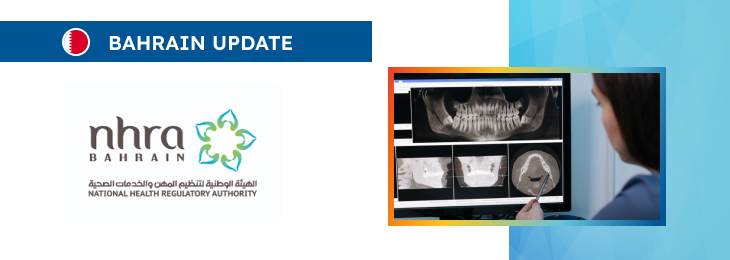The article highlights the key points related to the regulatory framework for implant cards as set forth under the current legislation.

Table of Contents
The National Health Regulatory Authority (NHRA), Bahrain’s regulating authority in the sphere of healthcare products, has published a draft guidance document dedicated to implant cards for active and non-active implantable medical devices intended to be marketed and used in the country.
Once finalized, the document will provide an overview of the applicable regulatory requirements, as well as additional clarifications and recommendations to be taken into consideration by medical device manufacturers and other parties involved in order to ensure compliance thereto.
The authority also reserves the right to make changes to the guidance and recommendations provided therein, should such changes be reasonably necessary to reflect corresponding amendments to the underlying legislation.
Introduction
First of all, the authority acknowledges the increasing use of medical implants in the sphere of healthcare to address various conditions. With this increasing reliance on implants, proper identification and documentation of these devices have become especially important.
Implant cards serve as a crucial tool in this process, ensuring patients and healthcare providers have immediate access to key information about the implants.

Definition of Implants
In order to assist the parties involved with the proper interpretation of the relevant regulatory provisions, the document provides definitions of the key terms and concepts used in the context of implantable devices including, inter alia, the following ones:
- Surgical Implants: A surgical implant refers to a device intended to be entirely inserted into the human body or to replace an epithelial surface or the surface of the eye through surgical intervention. These implants are designed to remain in place after surgery. Alternatively, they can be partially inserted into the body, intended to stay in place for at least 30 days.
- Active Implantable Medical Devices: An active implantable medical device is an active medical device that is surgically or medically introduced into the human body, either entirely or partially, or via a natural orifice, and intended to remain in place following the procedure.
- Non-Active Surgical Implants: A non-active surgical implant’s function does not rely on an external source of electrical energy or power, aside from that directly generated by the human body or gravity.
- Implant Card: An implant card is a document provided to patients post-surgery when an implantable or active implantable medical device has been inserted. This card serves as a main source of information about the implant for both patients and healthcare providers.
Purpose of Implant Cards
The document further outlines the purpose of implant cards and explains their importance in the context of public health protection.
According to the guidance, the main purposes of implant cards are:
- Ensuring Awareness and Traceability: The primary goal of implant cards is to ensure patients are informed about the details of their implants. This awareness aids both patients and healthcare providers in identifying specific devices and facilitates effective communication.
- Enhancing Safety: Implant cards also enhance device traceability, enabling prompt alerts to patients and healthcare providers about safety issues, including recalls and precautions.
Exempted Devices
Under the existing legal framework, some implantable devices, and similar items are exempt from the requirement to provide patient information materials.
These products include:
- Sutures
- Staples
- Dental fillings
- Dental braces
- Tooth crowns
- Screws, wedges, plates, wires, pins, clips, and connectors
- Devices intended to be absorbed by the body within six months of implantation, used as fillers, for hemostasis, tissue approximation, or for fixation of other medical devices.
Mandatory Requirements for Implant Cards
The present NHRA guidance also describes in detail the most important regulatory requirements implant cards are subject to.
For instance, implant cards must be readily accessible to patients and available in English, with Arabic as an option if applicable.
They may also include diagrams, drawings, or symbols. The card must include:
- Device name
- Device model
- Batch code, lot number, or serial number
- Unique Device Identifier (UDI), if applicable
- Manufacturer’s name, address, and website
If supplied electronically, the card must still fulfill these requirements.
Implant cards should be given to patients as soon as practical, allowing both patients and healthcare professionals quick access to the information.
The card may also provide additional space for:
- Surgeon’s name
- Patient’s name
- Date of implantation
- Name and address of the healthcare institution
In addition to the above, bar codes may be provided on stickers to help identify the device, provided they are:
- Durable
- Contain all required information in the correct form
In cases where implant cards contain some information and stickers contain the rest, the stickers can be adhered to the card at the point of care, ensuring compliance.
Conclusion
In summary, the present draft guidance issued by the NHRA emphasizes the important role implant cards play, ensuring patients and providers have immediate access to vital information about implanted devices. These cards enhance traceability, promote patient safety, and ensure that both patients and healthcare professionals are fully informed about the devices used in treatments. The document also outlines the scope of devices exempt from this requirement, and how manufacturers can comply with the mandatory standards, ensuring proper documentation and identification of medical implants.
How Can RegDesk Help?
RegDesk is a holistic Regulatory Information Management System that provides medical device and pharma companies with regulatory intelligence for over 120 markets worldwide. It can help you prepare and publish global applications, manage standards, run change assessments, and obtain real-time alerts on regulatory changes through a centralized platform. Global expansion has never been this simple.

